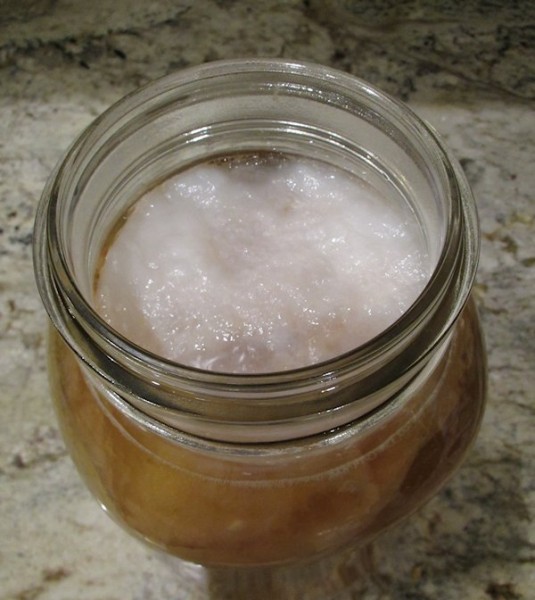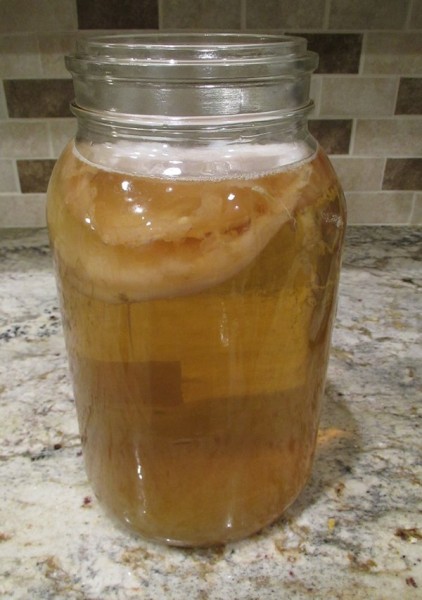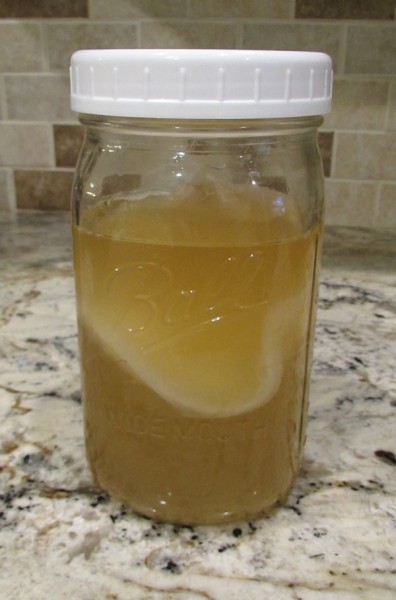Kombucha is merely a fermented tea that supposedly has health benefits. There’s a wealth of info on the internet about it but this is one site with info I found interesting. Before we went to the trouble of brewing and fermenting our own, we bought a few bottles at the health food store to try. I wasn’t crazy about it. My first thought was . . beer! It’s fizzy and foams over if not carefully poured. It has that little bit of yeasty/fermenty flavor that reminds me of beer and I am NOT a beer drinker. Vince was determined, after having read of the health benefits, that we were going to try making kombucha so we did, and now I love it. In fact, I have pretty much given up Dr. Pepper in favor of kombucha and now, when I drink a Dr. Pepper out, it just doesn’t give me that satisfaction that it once did.
This site has a good explanation of how to make kombucha.
The first and most essential part of making kombucha is to have a SCOBY. A SCOBY is a “symbiotic colony of bacteria and yeast”. It’s very similar in appearance and texture to a mushroom. A SCOBY can either be obtained from a friend (they grow and divide like crazy). I started out with a SCOBY from a friend and then I purchased one from Kombucha Kamp, which I highly recommend. Then I had two batches of tea going and then they multiplied and I divided and now I have four batches of kombucha fermenting.
For both previous divisions, I pulled the layers apart basically in the middle. The SCOBY reminds me of the flaky biscuits that are canned and when you bake them, they’re in thin layers. With each new batch of tea, a layer forms on top of the SCOBY and it keeps getting thicker and thicker.
Yesterday morning I was going to bottle a batch of brew and this is what I found on top of the tea.
I had not seen a new SCOBY so perfectly formed on top of the “mother”. This is what it looked like from the side.
You can see that the bottom portion, which is the mother SCOBY, already has almost separated itself into two layers, but the newest “baby” is at the very top. The thin white layer at the top will be the size of the mother after about three good ferments.
This batch yielded 5 – 32 oz. bottles, plus a little that I had to sample. To 4 cups of brewed/fermented tea, I add 1 cup of fruit juice (tart cherry in this batch), and then add 3/4 tsp. sugar to each bottle. The sugar will sweeten the brew a bit but mostly, it feeds the “critters” in the brew. These bottle will be “burped” twice a day to let off excess gas/fizz, then they will go into the fridge and then . . we will enjoy them! It isn’t mandatory that fruit juice be added . . the fermented tea can be served without added flavoring. So far, we’ve had tea with the following juices added: grape, prune, pineapple and tart cherry. The first time we used grape, it wasn’t our favorite but I was determined to use the last of the grape juice and when I added it to green tea, instead of black tea that we had first used, we really liked it. Now, they’re all our favorite flavors! 🙂
The baby SCOBY, along with about 2-1/2 cups of “starter” (kombucha from the last batch) will be going to my dentist so she can make her own brew. I was there yesterday and I knew she makes her own yogurt so I asked her if she was making kombucha and she said no but she wants to so . . I told her I’d bring her a SCOBY and my instructions.
It’s nice to share! 🙂





Lee says
I’m curious, as you speak of it fermenting, does it have alcohol content?
Judy Laquidara says
It does have some amount. Commercial kombucha must have less than .5% ABV. Homemade can run as high as 2.5%. Anything over 3% would require the use of grains and a third fermentation according to what I’ve read.
I would not serve it to a recovering alcoholic or a child but if you want to read more, there’s plenty of info available via Google.
Teresa says
Here is a great guide that was just published.
http://phickle.com/index.php/getting-started-and-faq/kombucha/